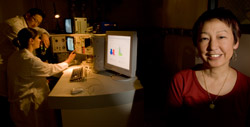FALL 2011 CONTENTS
Home
Game Change
On the verge of a revolution
Inside the labs
Highlighting recent Stanford cancer research
Cancer's biographer
A conversation with Siddhartha Mukherjee
The unexpected
Cancer during pregnancy
After cancer's cured
What's left to heal?
Make your own cancer diagnostic test
It's easier than you think

DOWNLOAD PRINTABLE
ISSUE (PDF)


High-dose dramaReconsidering a controversial cancer treatment
Breast cancer is always a scary diagnosis, but metastatic breast cancer — in which the cancer has spread beyond the breast — is among the scariest. Fewer than one in 20 of these patients are alive 10 years later. And new treatments during the past decade have added only a few months of life for most with this diagnosis.

Judith Shizuru wants to see if the good results of a tiny study for metastatic breast cancer hold up in a large one. Photo by Steve Fisch.
So Stanford’s Judith Shizuru, MD, PhD; Antonia Müller, MD; and their colleagues found reason for hope when they followed up on 22 metastatic breast cancer patients who had received an unusual treatment more than 10 years ago and discovered five were still alive, all but one with no signs of disease. The women, who had enrolled in the study between 1996 and 1998, had received chemotherapy at a much higher dosage than was standard — then had their decimated blood cell population replenished with their own purified blood stem cells.
Such positive results, albeit from a small study, might seem promising. But the reaction among many breast cancer researchers has been restrained, to say the least. The study reopens a painful episode in medical history — one that a large part of the medical community considers a closed case.
In the 1980s and 1990s, high-dose chemotherapy for metastatic breast cancer followed by transplants of the patients’ own blood stem cells had many enthusiastic backers, despite the fact that the therapy had life-threatening side effects and was unproven. Women with slight odds of surviving pushed for it, sometimes going to court against insurance companies that balked at paying. At the same time, private clinics sprang up to offer the therapy, and few were testing whether it worked.
“There were probably only about 720 women who were enrolled in trials that underwent transplant, out of the thousands who were treated outside of trials,” says Shizuru, associate professor of blood and bone marrow transplantation. Adding to the confusion and angst of the era, one of the trials turned out to be a fraud.
By the late 1990s, the first reputable clinical trial results were showing that high-dose chemotherapy worked no better than standard treatment. There was one important difference between these trials and the Stanford study, however: In the other trials, the stem cells were not purified, but were a mixture of cells from the blood and bone marrow, which likely contained cancer cells.
“We know that in metastatic breast cancer, about 40 percent of bone marrow and mobilized blood samples are contaminated with cancer cells, so it’s not surprising that unmanipulated grafts might contribute to breast cancer recurrence,” Shizuru says.
Those negative results came just when the Stanford group was ramping up its trial using purified stem cells. “Our trial was small because referrals just stopped coming,” she says.
Now, the Stanford trial’s tantalizing long-term results are prompting Shizuru and colleagues to call for further investigation with a larger, randomized study using cancer-free blood cells. “This is not a miracle cure, but it’s possibly a start, or at least a restart, on this issue,” says Shizuru.
— Christopher Vaughan

